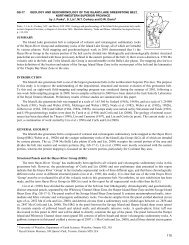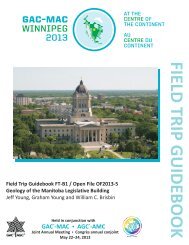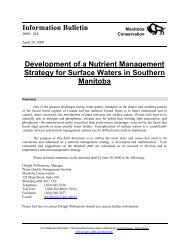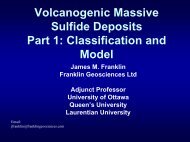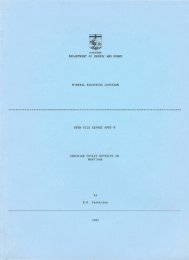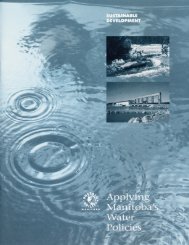Physical Volcanology, Hydrothermal Alteration and Massive ...
Physical Volcanology, Hydrothermal Alteration and Massive ...
Physical Volcanology, Hydrothermal Alteration and Massive ...
You also want an ePaper? Increase the reach of your titles
YUMPU automatically turns print PDFs into web optimized ePapers that Google loves.
eruptive cycle <strong>and</strong> are overlain by 60-400 m of subaqueous debris flow deposits <strong>and</strong>bedded epiclastic rocks. Like the High Level Lake pumice flows, rocks of the Tailings LakeSuccession are not found west of the Darkwater fault; however, they can be tracedeastward from this structure for more than 10 km. The debris flow deposits are composedof thick (5-120 m) massive basal units overlain by well bedded sedimentary material whichmay exhibit grading. The debris flows are composed of clasts derived from the underlyingash flow tuffs <strong>and</strong> from the precaldera rocks. The size <strong>and</strong> percentage of clasts increaseswestward toward the Darkwater fault <strong>and</strong>, in deep drill holes, downdip toward the backmargin of the caldera. Locally the debris flow deposits <strong>and</strong> associated sedimentary rocksare separated by dacitic ash tuffs <strong>and</strong> by dacitic to <strong>and</strong>esitic lava flows; these units onlyrarely crop out <strong>and</strong> are primarily observed in drill core. The ash tuffs are aphyric <strong>and</strong> finegrained,have Si0 2 contents that range from 65 to 77% <strong>and</strong> TiOa contents that areconsistently greater than 0.6%; they have locally undergone intense hydrothermalalteration. These rocks range from 5 to 80 m in thickness <strong>and</strong> are the host rocks to the,Mattabi E ore lens. The lava flows range in thickness from 10 to 50 m <strong>and</strong> vary frommassive to amygdaloidal <strong>and</strong> brecciated; locally these rocks are feldspar-phyric.The debris flow deposits represent the periodic avalanching of material from calderawalls, whereas the ash tuffs indicate sporadic eruption of felsic material, most likely alongleaky ring(?) fractures. The uppermost debris flows are composed of more than 60%precaldera mafic volcanic <strong>and</strong> High Level Lake ash flow tuff clasts, <strong>and</strong> are interlayeredwith abundant ash deposits. These units appear to represent renewed activity at calderamargins which immediately preceded the eruption of the overlying Mattabi ash flow tuffs.Mattabi Succession (Unit 6, Figs. 3 <strong>and</strong> 4)The Mattabi Succession represents the third <strong>and</strong> most voluminous eruptive eventwithin the caldera, forming deposits that exceed 1200 m in thickness. The deposits canbe traced across the caldera complex for more than 20 km <strong>and</strong> directly overlie debris flowor ash deposits of the Tailings Lake Succession east of the synvolcanic Darkwater fault;they overlie the High Level Lake quartz-rich ash flow tuff <strong>and</strong> mesobreccia deposits westof this structure. East of the Darkwater fault the Mattabi ash flow tuffs range from 1501200 m thick; they thin rapidly west of this structure (with the notable exception of the FZone area), ranging in thickness from 20-80 m. It is believed that the Darkwater fault10



